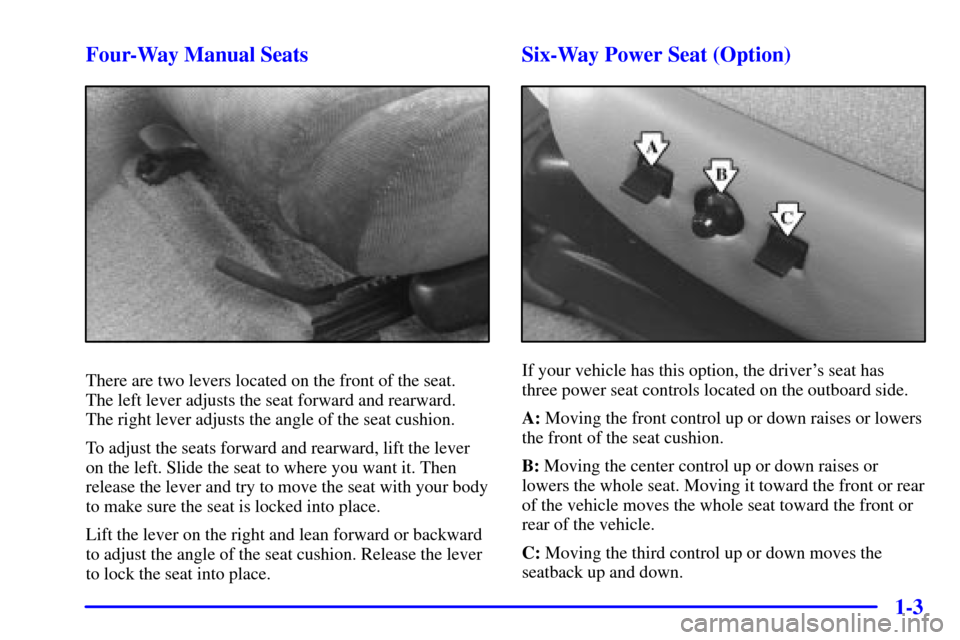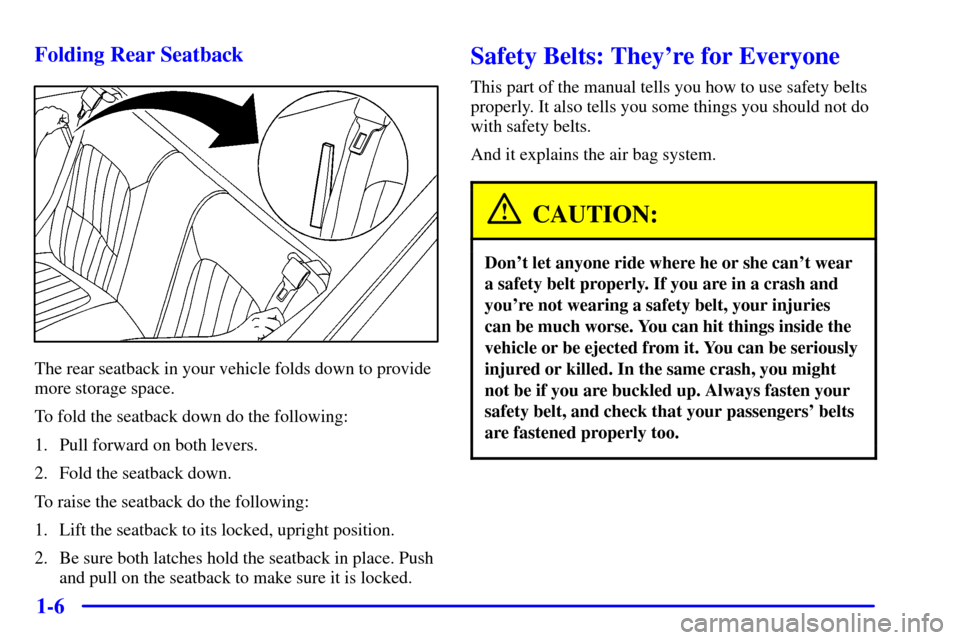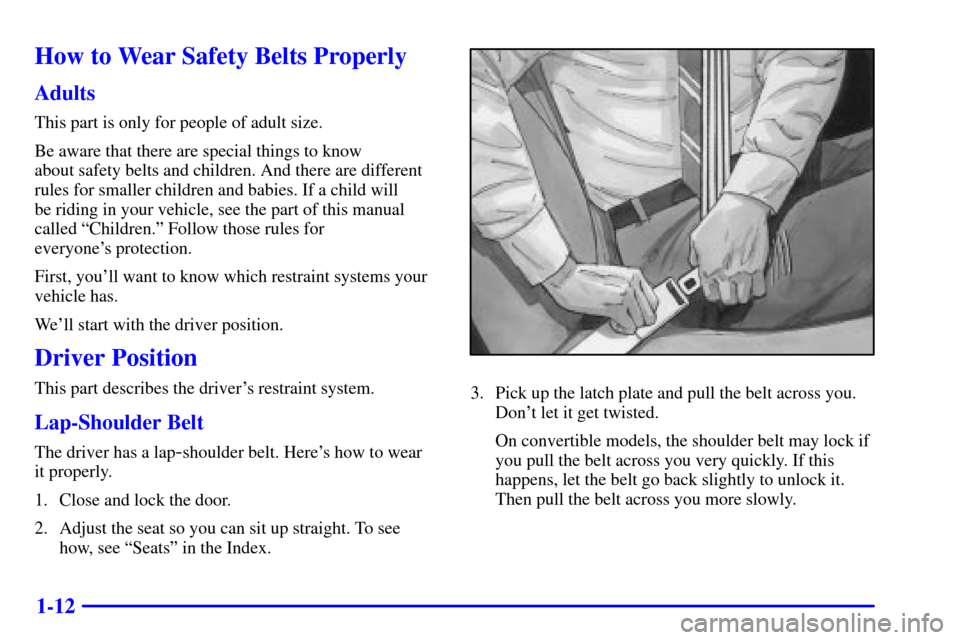Page 8 of 356
1-2
Seats and Seat Controls
This section tells you about the seats -- how to adjust
them and also about reclining front seatbacks, seatback
latches and the folding rear seatback.
Manual Front Seat
CAUTION:
You can lose control of the vehicle if you try to
adjust a manual driver's seat while the vehicle is
moving. The sudden movement could startle and
confuse you, or make you push a pedal when you
don't want to. Adjust the driver's seat only when
the vehicle is not moving.
Move the lever located under the passenger's front seat
to unlock it.
Slide the seat to where you want it. Then release the
lever and try to move the seat with your body to make
sure the seat is locked into place. Be sure the lever
returns to its original position after moving the seat.
Page 9 of 356

1-3 Four-Way Manual Seats
There are two levers located on the front of the seat.
The left lever adjusts the seat forward and rearward.
The right lever adjusts the angle of the seat cushion.
To adjust the seats forward and rearward, lift the lever
on the left. Slide the seat to where you want it. Then
release the lever and try to move the seat with your body
to make sure the seat is locked into place.
Lift the lever on the right and lean forward or backward
to adjust the angle of the seat cushion. Release the lever
to lock the seat into place.
Six-Way Power Seat (Option)
If your vehicle has this option, the driver's seat has
three power seat controls located on the outboard side.
A: Moving the front control up or down raises or lowers
the front of the seat cushion.
B: Moving the center control up or down raises or
lowers the whole seat. Moving it toward the front or rear
of the vehicle moves the whole seat toward the front or
rear of the vehicle.
C: Moving the third control up or down moves the
seatback up and down.
Page 10 of 356
1-4 Reclining Front Seatbacks
To adjust the seatback, lift the lever located on the
outboard side of the seat. Release the lever to lock the
seatback where you want it. Pull up on the lever without
pushing on the seatback and the seatback will move to
its upright position.But don't have a seatback reclined if your vehicle
is moving.
Page 11 of 356

1-5
CAUTION:
Sitting in a reclined position when your vehicle is
in motion can be dangerous. Even if you buckle
up, your safety belts can't do their job when
you're reclined like this.
The shoulder belt can't do its job. In a crash you
could go into it, receiving neck or other injuries.
The lap belt can't do its job either. In a crash the
belt could go up over your abdomen. The belt
forces would be there, not at your pelvic bones.
This could cause serious internal injuries.
For proper protection when the vehicle is in
motion, have the seatback upright. Then sit
well back in the seat and wear your safety
belt properly.
Front Seatback Latches
The front seatbacks fold forward to let people get into
the back seat.
To fold a seatback
forward, lift the latch
located on the lower
backside of the seatback.
When you return the seatback to its original position,
make sure the seatback is locked. The latch must be
down for the seat to work properly.
CAUTION:
If the seatback isn't locked, it could move forward
in a sudden stop or crash. That could cause injury
to the person sitting there. Always press rearward
on the seatback to be sure it is locked.
Page 12 of 356

1-6 Folding Rear Seatback
The rear seatback in your vehicle folds down to provide
more storage space.
To fold the seatback down do the following:
1. Pull forward on both levers.
2. Fold the seatback down.
To raise the seatback do the following:
1. Lift the seatback to its locked, upright position.
2. Be sure both latches hold the seatback in place. Push
and pull on the seatback to make sure it is locked.
Safety Belts: They're for Everyone
This part of the manual tells you how to use safety belts
properly. It also tells you some things you should not do
with safety belts.
And it explains the air bag system.
CAUTION:
Don't let anyone ride where he or she can't wear
a safety belt properly. If you are in a crash and
you're not wearing a safety belt, your injuries
can be much worse. You can hit things inside the
vehicle or be ejected from it. You can be seriously
injured or killed. In the same crash, you might
not be if you are buckled up. Always fasten your
safety belt, and check that your passengers' belts
are fastened properly too.
Page 18 of 356

1-12
How to Wear Safety Belts Properly
Adults
This part is only for people of adult size.
Be aware that there are special things to know
about safety belts and children. And there are different
rules for smaller children and babies. If a child will
be riding in your vehicle, see the part of this manual
called ªChildren.º Follow those rules for
everyone's protection.
First, you'll want to know which restraint systems your
vehicle has.
We'll start with the driver position.
Driver Position
This part describes the driver's restraint system.
Lap-Shoulder Belt
The driver has a lap-shoulder belt. Here's how to wear
it properly.
1. Close and lock the door.
2. Adjust the seat so you can sit up straight. To see
how, see ªSeatsº in the Index.
3. Pick up the latch plate and pull the belt across you.
Don't let it get twisted.
On convertible models, the shoulder belt may lock if
you pull the belt across you very quickly. If this
happens, let the belt go back slightly to unlock it.
Then pull the belt across you more slowly.
Page 19 of 356

1-13
4. Push the latch plate into the buckle until it clicks.
Pull up on the latch plate to make sure it is secure.
If the belt isn't long enough, see ªSafety Belt
Extenderº at the end of this section.
Make sure the release button on the buckle is
positioned so you would be able to unbuckle the
safety belt quickly if you ever had to.
5. To make the lap part tight, pull down on the buckle
end of the belt as you pull up on the shoulder belt.
The lap part of the belt should be worn low and snug on
the hips, just touching the thighs. In a crash, this applies
force to the strong pelvic bones. And you'd be less likely
to slide under the lap belt. If you slid under it, the belt
would apply force at your abdomen. This could cause
serious or even fatal injuries. The shoulder belt should go
over the shoulder and across the chest. These parts of the
body are best able to take belt restraining forces.
The safety belt locks if there's a sudden stop or crash.
On convertible models, the safety belt also locks if you
pull the belt very quickly out of the retractor.
Page 32 of 356
1-26
Rear Seat Passengers
It's very important for rear seat passengers to buckle up!
Accident statistics show that unbelted people in the rear
seat are hurt more often in crashes than those who are
wearing safety belts.
Rear passengers who aren't safety belted can be thrown
out of the vehicle in a crash. And they can strike others
in the vehicle who are wearing safety belts.
Lap-Shoulder Belt
1. Pick up the latch plate and pull the belt across you.
Don't let it get twisted.
On convertible models, the shoulder belt may lock if
you pull the belt across you very quickly. If this
happens, let the belt go back slightly to unlock it.
Then pull the belt across you more slowly.